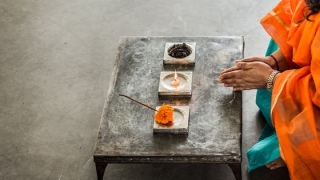The wisdom of Ayurveda and Yoga for the Fall season
I think you will agree with me when I say that the changing season can be harsh on us... As the temperature starts to cool down, we tend to experience more dryness, roughness, rigidity...
In Ayurveda this season is characterized by increased Vata dosha: dry, cold, rough, rigid, light, thin qualities.
With the following points, step-by-step, you can make the changing season and the transition smooth:
- Dinacharya: Use copper tongue scraper every morning to remove toxins / amas from the tongue. Make the warm sesame oil body massage as a regular or alternate day routine. Do nasya with sesame oil or clarified butter (ghee). Start your day with warm ginger, lemon and honey tea or tulsi, ginger and turmeric tea
- Ahara and Nidra: Avoid the over use of bitter, astringent and spicy foods. Focus on eating warm, cooked meals with emphasis on good fats (ghee, nuts etc), nourishing and mushy foods. Avoid raw, cold and frozen foods, iced and aerated drinks. Make sure you rest well and avoid over working. Do some restful activity like a short meditation between 5-7 pm (sandhi of the vata and kapha dosha). A small step like lighting a lamp/tea light candle can bring so much spark, positivity, hope and cheer to life. The practice of Yoga Nidra at least once a week can be extremely grounding
- Shat Kriyas: Practice Agni Sara and Nauli upon waking up in the morning, after drinking a half glass of warm water. This will help awaken, strengthen and establish the rhythm between the digestive, reproductive and excretory systems
- Apana Kriyas: Surya Namaskara with Gayatri mantra can help in bringing a balance of tri doshas. Make sure you do not overdo it. Just one round with emphasis on stretches can help warm up the body, open up the pores, awaken the agni and move the imbalanced doshas
- Asana: If you have an everyday asana practice, focus on including seated forward fold to calm down vata in the upper body, a gentle back bend to awaken the agni, and a relaxation asana to foster deep relaxation. Find more on Shat Kriyas, Apana Kriyas and Asanas in this book
- Tanmatra Chikitsa: Vata creates isolation and scattering of the five senses. Focus on the heart space (the seat of pratyahara) and pay attention to the touch, sound, smell, taste and vision of breath. Do this for 1-2 minutes, twice a day
- Pranayama: Avoid any harsh pranayama like ujjayi, bhastrika or any sort of kumbhaka. Practice soothing pranayama like bhramari (humming bee) or Pranava (chanting the syllables of AUM individually upon exhalation)
- Mantra: Focus on the mental japa of Gayatri mantra or Beeja "Om Hreem" co-ordinating with your breath
- Mudra: Practice Linga Mudra (2 times a day for 2-5 minutes each time you practice) to keep the warmth in the lungs and air passages strong
- Get professional support / help: Get in touch with your Yoga Therapist and/ or Ayurvdic counselor for specific diet, practice and herbal protocols related to your specific dosha, agni and season
What is the bottom line? These steps will help your body and mind to adjust and you will feel better.
Want to know more about ayurveda? Join me! Essential Ayurveda for Yoga Professionals, Starting Aug 23, 2023



